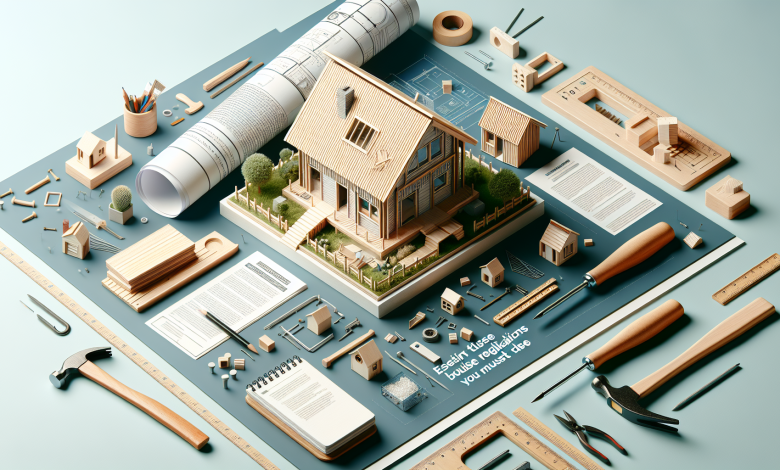Essential Tiny House Building Regulations You Must Know

Tiny House Building Regulations You Need to Know
Tiny house building regulations are essential for anyone considering a downsized lifestyle. Understanding these regulations is crucial to ensure compliance with local laws and to avoid potential legal issues. In this article, you will learn about the various building codes, zoning laws, and the permitting process involved in tiny house construction, along with safety and health standards that apply to these unique living spaces.
Introduction to Tiny House Building Regulations
The tiny house movement has gained significant momentum in recent years, appealing to individuals seeking minimalism, affordability, and a sustainable lifestyle. This trend has led to a rise in the construction of tiny homes, but with this growth comes the need for a deeper understanding of tiny house building regulations. These regulations vary widely across regions and can significantly impact your ability to build a tiny house.
Understanding building regulations is vital for several reasons. First, they ensure that homes meet safety and health standards, protecting residents and the community. Second, being compliant with local laws can prevent potential fines and the dismantling of your home. Therefore, it’s imperative for prospective tiny house owners to familiarize themselves with the specific regulations in their area.
In the following sections, we will explore various aspects of tiny house building regulations in detail.
General Building Codes and Zoning Laws
Building codes refer to the standards that govern the construction and renovation of buildings, ensuring they are safe, habitable, and accessible. These codes vary from one jurisdiction to another, so it’s essential to consult local regulations when planning your tiny house. Common aspects covered by building codes include structural integrity, electrical and plumbing systems, and fire safety measures.
Zoning laws, on the other hand, dictate how land can be used in certain areas. They can restrict the size, placement, and type of structures that can be built, which directly affects tiny houses. Some areas may have specific zoning classifications for tiny homes, while others may not allow them at all. Tiny House Construction Materials: Key Considerations hakkında daha fazla bilgi edinin.
Understanding both building codes and zoning laws is fundamental to successfully navigating the tiny house construction process.
Types of Tiny Houses and Their Regulations
Tiny houses generally fall into two categories: those built on wheels (often referred to as tiny house trailers) and those built on foundations. Each type has distinct regulations. Tiny houses on wheels may be classified as RVs in some jurisdictions, subjecting them to different standards than traditional homes.
Size limitations are another critical factor. In many areas, a tiny house is typically defined as a dwelling of less than 400 square feet. However, the exact size limit can vary, impacting your design choices significantly.
By recognizing the differences in regulation based on the type of tiny house, you can better prepare for your construction project.
Permitting Process for Tiny Houses
Obtaining the necessary permits for building a tiny house can be a complex process. Typically, you will need to submit plans that demonstrate compliance with local building codes and zoning laws. This often includes architectural drawings and engineering calculations. Why Good Insulation is Essential for Tiny Homes hakkında daha fazla bilgi edinin.
Common challenges in the permitting process include navigating bureaucratic red tape, addressing objections from neighbors, and ensuring that your plans meet the specific requirements of your locality. It is crucial to be patient and thorough when dealing with these challenges.
By understanding the permitting process, you can minimize delays and ensure a smoother construction experience.
Safety and Health Regulations
Safety standards are crucial in tiny house construction, covering elements such as electrical wiring, plumbing, and fire safety. For example, tiny houses must have proper smoke detectors and fire extinguishers installed to comply with safety regulations.
Health regulations also play a significant role in tiny house living. These can include requirements for ventilation, sanitation, and waste disposal. Ensuring these standards are met is vital not only for legal compliance but also for the health and comfort of the inhabitants.
Meeting these safety and health regulations is essential for the well-being of residents and the overall success of your tiny house project. Tiny House Challenges: What to Expect in 2024 hakkında daha fazla bilgi edinin.
Navigating Local Regulations and Best Practices
To successfully navigate local regulations, thorough research is critical. Begin by visiting your city or county’s website for zoning maps and building codes related to tiny houses. Additionally, consider reaching out to community forums or local tiny house builders for insights and guidance.
Working with local authorities can also facilitate the process. Establishing a positive relationship with officials can provide clarity and help address any concerns that may arise during the permitting process.
By proactively researching and engaging with local authorities, you can better navigate the complexities of tiny house regulations.
Conclusion: Staying Compliant with Tiny House Regulations
In conclusion, understanding tiny house building regulations is fundamental for anyone looking to embrace this growing movement. Compliance not only protects you legally but also ensures the safety and health of the occupants. As the tiny house trend continues to evolve, staying informed about future regulations will be essential. Whether you are just starting your tiny house journey or are already in the process, make compliance a priority to enjoy the benefits of tiny house living.




